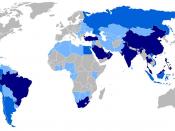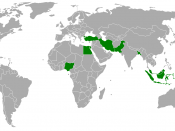One of the key aspects of economics that can define a country's market is aid received from various sources. Even though aid is generally received by developing countries, most countries in general have at some point or another been the recipient or the donor. Aid is described as help or assistance for support and relief. In economics however, it can mean much more than that, as there are times when aid can transform a nation.
There are several different types of foreign aid with the most common being bilateral, multilateral, official and tied aid. First of all, the type of aid that is most common is bilateral aid which is basically direct aid from one nation to another. Multilateral aid on the other hand is similar but the donors can be numerous. This type of aid can also come from authorized organizations such as the World Bank and International Monetary Fund.
Official aid is usually funded by the government of a country and it is recognized by recipients. Tied aid is quite unique from the other common types of support as it involves poor countries buying goods and services from donor countries at higher prices in exchange for the donations received by the recipient.
There are also other types of aid such food and technical aid as well as debt cancelling. Technical aid is very useful for developing countries since it can help certain infrastructures. Food aid on the other hand can eradicate poverty and contribute drastically in emergencies and relief. Debt cancelling is also one critical type of relief since it can get a country on its feet. However, this strategy can be a very long term process as debt cancelling can take years and the interest that the donor country receives can be very high.
Another type of aid that is very common is NGO's that exist in almost every country. Agencies such as Oxfam, Red Cross, Save the Children and Care are examples of organizations that are usually privately run and help out in improving the lifestyles and well being of the less unfortunate. These organizations are also the first ones to react whenever a disaster strikes such as the tsunami or the recent hurricane. NGO's are non government organizations which can influence important figures all over the world through the powerful impact that they usually have in the media.
Even though the aid coming form donor countries are targeted towards the improvement of life to the recipient, most often, it is the donors who benefit the most. A very common example of this situation is when aid is provided for debt cancellation. Developing countries are most often the recipients however, large sums of interests are included which can delay the debt cancellation of the recipient. This makes the situation a long term problem and thus, more and more interest is piled on. The donor is highly beneficial this way as the longer the debt cancellation takes, the more money the donor can earn. On the other hand, the recipient also risks the possible increase of indebtedness.
Another example that donor countries benefit more from aid is when support is given to finance imports from donor countries. The donor usually gives money in aid so that the recipient can buy imports from the donor. This way, the production of industries in the donor country increases vastly. Aid is also given to support political regimes sympathetic to donor countries which are evident in certain parts of the world. An example of this can be seen in Afghanistan where western donor countries provide aid to political regimes that were set up by donor countries. This way, the donor country is very beneficial as they usually contribute to a large extent on the political regime of the recipient country.
Donor countries benefit from aid when they provide employment in the industries of the donor country. This advances the industries of the donor countries to a large extent as the employees are from recipient countries and often work at lower wages. The advancement of the industry from the donor can again contribute to their benefits as the products that are made can be later sold to even the recipient country.
Although, these factors do point towards the donor country benefiting more form the aid that is given by them, recipient countries are also beneficial as the initial purpose of the aid given is to help them. Recipient countries are usually given money to help develop their infrastructures and their economy. Crucial factors such as bridging the savings gap can be covered with aid from donors. Another aspect is regarding the debt of the recipient country which can be easily removed with good financing of relief. Even though it will come with interests and will ultimately depend on the amount of debt the recipient faces, if proper money is given as aid, debts can be relieved.
Recipient countries can benefit from aid which is given to bridge the foreign exchange gap. This is highly useful for developing countries that target the advancement of their economy compared with much developed, donor countries. Developing countries can also benefit as the recipients when donors give aid to finance infrastructure projects in LDC's. This can once again benefit the donor as well as they can have a strong influence in the recipient country by building projects that will benefit the recipient.
One other form of aid that can be seen as quite different from the rest is emergency relief. The uniqueness of this is more or less down to the scale and frequency of emergencies. NGO's have critical roles to play during emergencies as their work is highly regarded and valued. Other aids during emergencies are as important as relief during emergencies is imminent and come in various forms such as bilateral, multilateral and official. Even though the donor nor the recipient are more beneficial than the other when it comes to emergency aid, it can be seen as more useful towards the recipient as the economy can be affected severely.
In the end, the aid that comes from different sources is beneficial to both the recipient and the donor. There are occasions when one is in a more advantageous situation depending on the circumstances. The factor that can eventually make the biggest difference is the type of aid that is being given by the donor and the clauses that the recipient faces when the aid must be returned.


